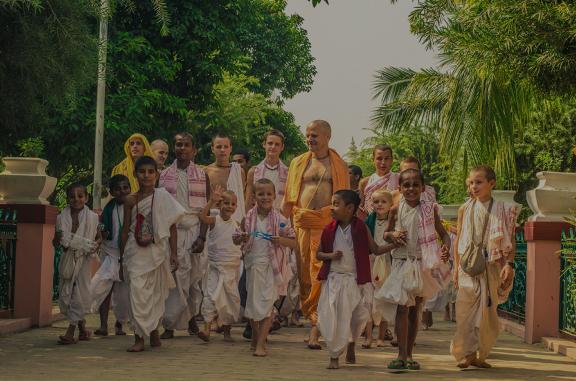In the context of the International Society for Krishna Consciousness (ISKCON), the Shiksha Ceremony holds a unique significance. ISKCON, also known as the Hare Krishna movement, is a global organization founded by A.C. Bhaktivedanta Swami Prabhupada in 1966, with a focus on the teachings of Bhagavad Gita and the practice of devotional service to Lord Krishna.
In ISKCON, the Shiksha Ceremony is a formal initiation ceremony through which individuals commit themselves to the spiritual path outlined by the organization's teachings. Here's an overview of the process:
- Aspiring Devotees: Individuals who are interested in becoming serious practitioners of Krishna consciousness and adopting the principles of ISKCON are considered aspiring devotees.
- Preparation: Before the Shiksha Ceremony, aspiring devotees typically undergo a period of study, training, and spiritual practice under the guidance of senior devotees and mentors. This includes attending classes, reading sacred texts, and participating in devotional activities.
- Formal Acceptance: The Shiksha Ceremony represents a formal commitment to the teachings of ISKCON and a pledge to follow its principles. During this ceremony, aspiring devotees publicly express their dedication to the spiritual path.
- Mantras and Vows: The ceremony often includes the chanting of specific mantras and the acceptance of vows known as the "four regulative principles." These principles are abstaining from meat-eating, illicit sex, intoxication, and gambling.
- Spiritual Names: As part of the ceremony, aspiring devotees are given spiritual names that carry deep spiritual significance. These names often reflect the individual's commitment to the devotional path.
- Blessings: Senior devotees, mentors, and sometimes even ISKCON leaders participate in the ceremony. They offer blessings, guidance, and encouragement to the aspiring devotees.
- Saffron or White Cloth: Depending on the level of commitment and initiation, devotees might receive either a saffron or white cloth to wear as a symbol of their dedication to the spiritual path.
The Shiksha Ceremony in ISKCON is not the same as the formal initiation known as "Diksha." Diksha involves a deeper level of commitment and connection with a spiritual teacher (guru), and it often includes additional vows and practices.
The Shiksha Ceremony is a significant step for those who wish to align themselves with ISKCON's teachings and engage in a life dedicated to devotional service and spiritual growth.
LEVEL 1 : Sraddhavan
- To be an active devotee and to attend the programs regularly, participate and associate with Krishna Conscious devotees.
- To chant at least one round of Hare Krishna Maha-mantra every day.
- To read the teachings of Lord Krishna as given in the books of Srila Prabhupada.
LEVEL 2: Krishna Sevak
- To be dedicated to taking the divine shelter of Srila Prabhupada by following the principles of Krishna Consciousness.
- To accept that Lord Krishna is the Supreme Personality of Godhead.
- To engage in practical devotional service to Lord Krishna during festivals such as Sri Krishna Janmastami, Gaura Purnima, etc.,
- To chant a minimum of four rounds of the Hare Krishna Maha-mantra everyday
- To refrain from eating non-vegetarian food (meat, fish and eggs) and try to lead a moral life.
LEVEL 3: Krishna Sadhaka
- To be dedicated to leading a devotional way of life, by gradually learning and practicing Bhakti-Yoga, according to the teachings of Srila Prabhupada under the guidance of his representatives.
- To study the books of Srila Prabhupada and attend the classes as often as possible (atleast the weekend Bhagavad-Gita class every week)
- To worship Lord Krishna, as far as practical in the home, by setting up an altar, offering arati and foodstuffs, worshiping the sacred Tulasi plant and following basic sadhana like rising up early in the morning.
- To Chant eight to sixteen rounds of the Hare Krishna Maha-Mantra every day.
- To lead a pure holy life by avoiding intoxication (alcoholic drinks and smoking), meat-eating, gambling and extra-marital sex.
- To observe fasting on the Ekadasi and festival days as indicated in the Vaisnava Calendar.
LEVEL 4: Srila Prabhupada Ashraya
- To be dedicated to taking divine shelter of Srila Prabhupada by following the principles of Krishna Consciousness.
- To practice Krishna Consciousness with strong conviction.
- To chant a minimum of sixteen rounds of the Hare Krishna Maha-mantra every day.
- To strictly avoid intoxication including coffee and tea, meat eating including onion and garlic, gambling, mundane cinema, sports and illicit sex.
- To be well versed in the basics of Krishna conscious philosophy by reading the books of Srila Prabhupada systematically and is actively engaged in preaching (according to his/her capacity) to others about Krishna Consciousness.
- To do some responsible service (however simple it may be), on a regular basis.
- To follow a strict sadhana program at home by rising early in the morning and following a program similar to the temple as far as possible.
- And to attend at least one Srimad Bhagavatam/Srimad Bhagavad-Gita class every week.
LEVEL 5: Sri Guru Charana Asraya
- After a minimum of six months of following Srila Prabhupada Ashraya Standards, one may select an ISKCON authorized diksha guru, from amongst ones established siksa gurus.
- Note that six months is the minimum period, and one may take as much time as required to make this selection.
- Responsibility of candidates to choose guru by the exercise of their own intelligence.
- Notify the local Temple President or relevant authority
- Take written examination issued by ISKCON authority
- Receive formal letter of recommendation from ISKCON authority.
- Receive permission from the selected guru.
For the scheduled event date please check the vaishnava calendar.
